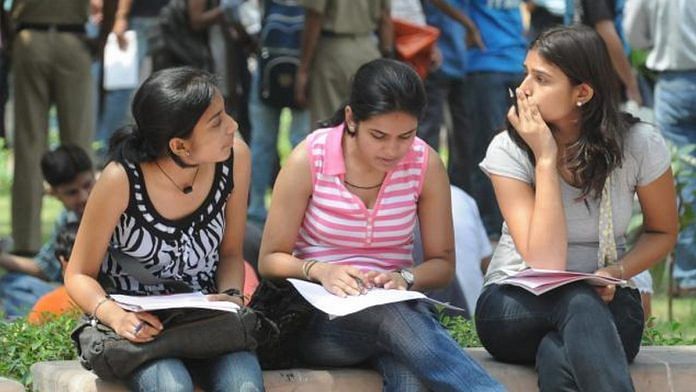New Delhi: A group of researchers, including University Grants Commission (UGC) Vice-Chairman Bhushan Patwardhan, has suggested changing the way enrollment in higher education is calculated in India.
At present, India’s higher education enrollment is calculated in terms of Gross Enrollment Ratio (GER), which is the ratio of population in the 18-23 age group to the number of people enrolled in higher education. According to the All India Survey on Higher Education (AISHE), India’s GER was 27.4 per cent for 2017-18.
This, in effect, means out of the total population in the age group of 18-23 in India, 27.4 per cent attend college and university.
The researchers have suggested that instead of GER, India should look at Eligibility Enrollment Ratio (EER), which is the ratio of eligible population — those who have at least passed Class 12 in the 18-23 age group — to the number of people attending college.
According to the research paper, if India uses EER as the measuring metric, its enrollment rate in higher education will increase to 64.9 per cent for 2017-18 — bringing it at par with developed countries.
At present, the paper says, the higher education sector in India consists of 3.74 crore students across 993 universities, 39,931 colleges, and 10,725 stand-alone institutions, according to the AISHE-2019.
The paper making the suggestion to the Narendra Modi government has been published by a team of researchers including Pankaj Mittal and Ashwani Kharola who are with the Association of Indian Universities (AIU), Anjali Radkar who teaches at the Gokhale Institute of Politics and Economics, Pune, and Anitha Kurup of the National Institute of Advanced Studies, Bengaluru, besides Bhushan Patwardhan.
Also read: Why Modi govt is planning to take its university ranking system NIRF global
‘EER the more refined measure’
According to the paper published in ‘Economic and Political Weekly’, the researchers “propose that, for India, EER would be the most appropriate indicator rather than mere GER for assessing the access, quality, and relevance to higher education”.
The paper argues that EER will be more appropriate because access to primary education in India is poor and hence making a comparison with the entire population as opposed to the eligible population would be unfair.
It also states that the EER would ensure a change in education pedagogy in India, with efforts to improve the quality of school education and give more importance to skill and vocational training.
The paper adds that EER might be a “refined measure to position developed and developing countries on the same plane and, therefore might portray a fairer picture about the enrollment in higher education”.
GER and EER
Taking 2017-18 as a reference year, the paper has studied GER of 10 nations — US, UK, France, Germany, Brazil, China, Indonesia, India, South Africa and Pakistan. It concludes that US has the highest GER at 88.2 per cent, followed by Germany (70.3 per cent), France (65.6 per cent), UK (60.6 per cent), Brazil (51.3 per cent), China (49.1 per cent), Indonesia (36.4 per cent) and India (27.4 per cent in 2017-18, 26.3 per cent in 2018-19). The two nations below India are South Africa (22.4 per cent) and Pakistan (9.4 per cent).
“The GER in higher education for India is lower as compared to developed nations because a large population of students in the relevant age group is simply not eligible to enrol in colleges because they have not successfully completed the 12th grade higher secondary education,” the paper states. “Hence, focusing on the expansion of higher education to increase GER is misplaced.”
“It is against this background that we hypothesise that GER may not be the appropriate measure or indicator for developing countries like India because of a large gap between the number of students available in the age group of 18-23 and those eligible, inter alia, to enter in higher education,” it adds.
According to the paper, India’s EER of 64.9 per cent would bring it at par with the EER of UK (63.1 per cent), China (72.9 per cent) and France (75.5 per cent). The US would still have the highest EER at 93.5 per cent, followed by Germany at 91.2 per cent.
Also read: Modi govt to ensure Class 10 students who didn’t write board exams are not hassled




How about next academic years student appearing for grade 10 IGCSE
WHAT WILL BE THE PORTION HOW WILL THEY COPE UP ?
Does higher education include undergrad students?
In this article, it is not clear what the societal goal is.
If the objective is to increase the number of people who gain a college degree, then switching to EER will create a false sense of achievement. If the objective is to divert people from UGC managed college degrees to more vocational training, then this might make sense. A focus on EER will not create excess capacity in colleges, exceeding the output of schools.
By not explaining the intent behind the author’s of the paper or even establishing the MHRD’s goals on higher education in the country, this article leaves the reader confused.